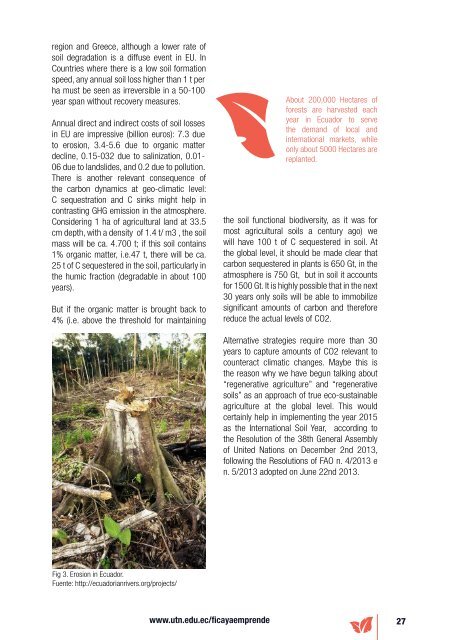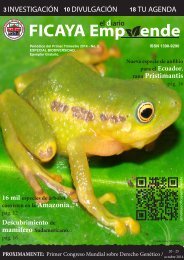You also want an ePaper? Increase the reach of your titles
YUMPU automatically turns print PDFs into web optimized ePapers that Google loves.
egion and Greece, although a lower rate of<br />
soil degradation is a diffuse event in EU. In<br />
Countries where there is a low soil formation<br />
speed, any annual soil loss higher than 1 t per<br />
ha must be seen as irreversible in a 50-100<br />
year span without recovery measures.<br />
Annual direct and indirect costs of soil losses<br />
in EU are impressive (billion euros): 7.3 due<br />
to erosion, 3.4-5.6 due to organic matter<br />
decline, 0.15-032 due to salinization, 0.01-<br />
06 due to landslides, and 0.2 due to pollution.<br />
There is another relevant consequence of<br />
the carbon dynamics at geo-climatic level:<br />
C sequestration and C sinks might help in<br />
contrasting GHG emission in the atmosphere.<br />
Considering 1 ha of agricultural land at 33.5<br />
cm depth, with a density of 1.4 t/ m3 , the soil<br />
mass will be ca. 4.700 t; if this soil contains<br />
1% organic matter, i.e.47 t, there will be ca.<br />
25 t of C sequestered in the soil, particularly in<br />
the humic fraction (degradable in about 100<br />
years).<br />
But if the organic matter is brought back to<br />
4% (i.e. above the threshold for maintaining<br />
About 200,000 Hectares of<br />
forests are harvested each<br />
year in Ecuador to serve<br />
the demand of local and<br />
international markets, while<br />
only about 5000 Hectares are<br />
replanted.<br />
the soil functional biodiversity, as it was for<br />
most agricultural soils a century ago) we<br />
will have 100 t of C sequestered in soil. At<br />
the global level, it should be made clear that<br />
carbon sequestered in plants is 650 Gt, in the<br />
atmosphere is 750 Gt, but in soil it accounts<br />
for 1500 Gt. It is highly possible that in the next<br />
30 years only soils will be able to immobilize<br />
significant amounts of carbon and therefore<br />
reduce the actual levels of CO2.<br />
Alternative strategies require more than 30<br />
years to capture amounts of CO2 relevant to<br />
counteract climatic changes. Maybe this is<br />
the reason why we have begun talking about<br />
“regenerative agriculture” and “regenerative<br />
soils” as an approach of true eco-sustainable<br />
agriculture at the global level. This would<br />
certainly help in implementing the year 2015<br />
as the International Soil Year, according to<br />
the Resolution of the 38th General Assembly<br />
of United Nations on December 2nd 2013,<br />
following the Resolutions of FAO n. 4/2013 e<br />
n. 5/2013 adopted on June 22nd 2013.<br />
Fig 3. Erosion in Ecuador.<br />
Fuente: http://ecuadorianrivers.org/projects/<br />
www.utn.edu.ec/ficayaemprende<br />
27








